Disclosure: Meeple Mountain received a free copy of this product in exchange for an honest, unbiased review. This review is not intended to be an endorsement.
Man, I love a good mobster theme.
That starts with my love for the mainstream Mafia movie canon. Sure, everyone loves the Godfather films…the classics are classic for a reason. Ditto for Goodfellas, Casino, and nearly everything done by Martin Scorsese. I have a preference for flicks like The Untouchables or newer takes like Gangster Town, The Departed (based on a Hong Kong film called Infernal Affairs—which I think is the better film), Public Enemies, and any of the older flicks reminding us of Prohibition-era crime.
I love gang, mobster, and crime themes, to the point where my wife knows that if there’s a new TV show coming out that gives her “those ‘Narcos’ vibes” (her words), I’m going to watch it. Anything featuring illegal drugs, booze, drive-by shootings, and infamous real-world crime figures is a 100% go for my personal viewing tastes.
My appreciation for mobster themes carries over into board games. Whether it is Scarface 1920, La Famiglia: The Great Mafia War, Speakeasy Blues, or The Godfather: Corleone’s Empire, I am all the way in if a game gives me the chance to celebrate the music of the 1920s and 30s, force opposing gang associates to “swim with the fishes”, or drive a car bomb into a neighborhood.
Given this history, it should come as no surprise that when Eagle-Gryphon Games reached out to see if we were interested in covering the 2025 Vital Lacerda crime-themed game Speakeasy, I couldn’t express my interest fast enough.

I love Lacerda games. I’ve already covered two other Lacerda games this year, bringing my Lacerda article count here at Meeple Mountain up to seven.
And to learn that Lacerda was doing a game about the 1920s Prohibition-era Mafia wars in New York City? I was locked in. But I had one major concern. After the scale up in difficulty between Weather Machine and Inventions: Evolution of Ideas, recent Lacerda designs felt like the Portuguese designer was making games that were getting incredibly difficult to internalize…would Speakeasy continue down the path of “complexity for complexity’s sake?”
I am happy—overjoyed, frankly—that Speakeasy has a toned-down ruleset, with a complexity that falls more in line with my personal Lacerda favorites, such as Vinhos: Deluxe Edition, The Gallerist, and Kanban EV. Speakeasy gets back to a design philosophy that delivers a game that is “only” challenging, not mind-numbingly brain melty.
With Speakeasy, the integration of theme and the interlocking game mechanics might be the best work Lacerda has ever done, which is saying something considering that I thought he would never top the thematic work he did with The Gallerist and Kanban EV. (In the case of the latter: have you ever played a game where it felt more like you were going to work for a tough boss?)
My thoughts on the pre-production copy (PPC) of Speakeasy are summarized below. Please note that while the game’s rules are final, there is always the chance that minor details and the addition of mini expansions change between the time of this post and when the game releases in 2025. All pictures are of the PPC’s components, but you wouldn’t know it from the sheer beauty of this product.
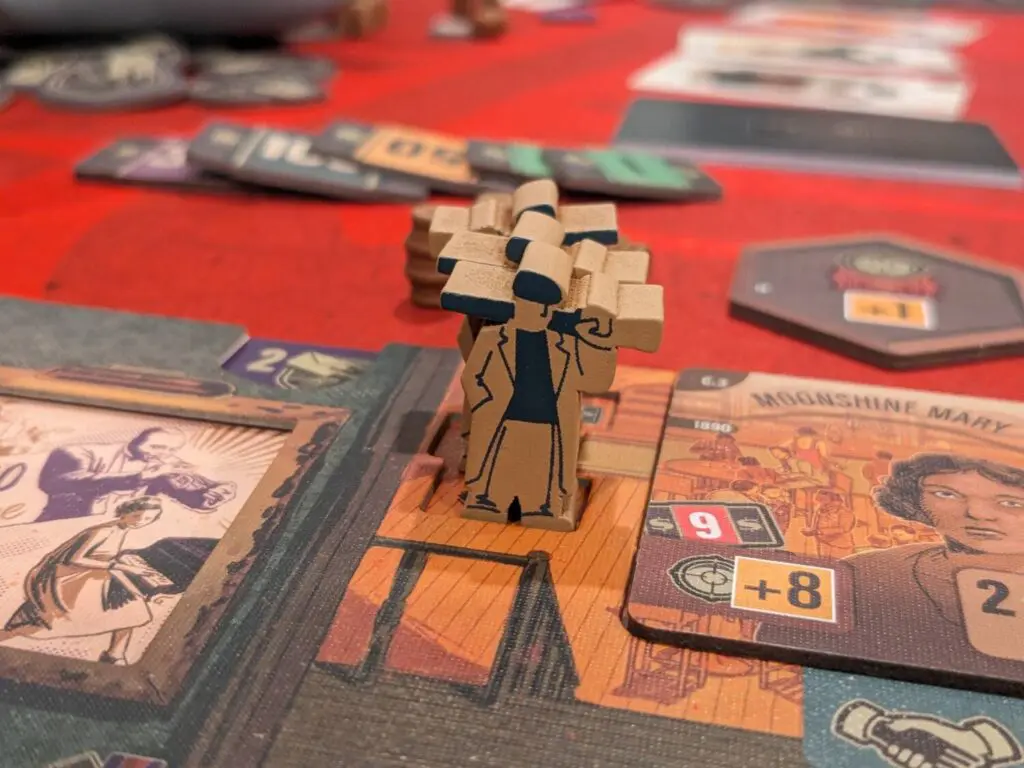
A Note About the Rules
Speakeasy is an area control, worker placement, and hand management game that plays in about 45 minutes per player. For this review, I played the game a few more times than normal. While I usually play a game three times before posting a review, I played Speakeasy seven times: once with three players, and twice at all other player counts (solo, two-player, and four-player).
The first place where you will notice the stripped-down (for a Lacerda) nature of the ruleset is with the solo mode. Lacerda’s solo modes have usually been too complex for what you got out of the gameplay, and I would never recommend his games based only on the solo modes. Mix that with the fact that Speakeasy’s solo mode was designed by three people—Lacerda, Shelley Danielle, and Dávid Turczi (yes, that Turczi)—and I was scared to death that the solo mode would feature a dedicated 10-page rulebook.
Then I opened the PPC and found a solo mode sheet that probably could be printed on the inside back cover of the rulebook. It was shocking how simple it was to learn the solo mode. Even Turczi’s work on Kanban EV’s solo mode—easily the best solo mode I’ve tried in a Lacerda—was much more complex than I thought it needed to be, despite how much I enjoyed it.
In Speakeasy, solo mode is as simple as putting together a small deck of cards with a specific list of icon-driven commands that mimic what a player would do in the main game. I tried the solo mode twice and each solo play took less than an hour. I only had to reference the small rules pamphlet a couple times to understand what the automa would do if its initial options were compromised.
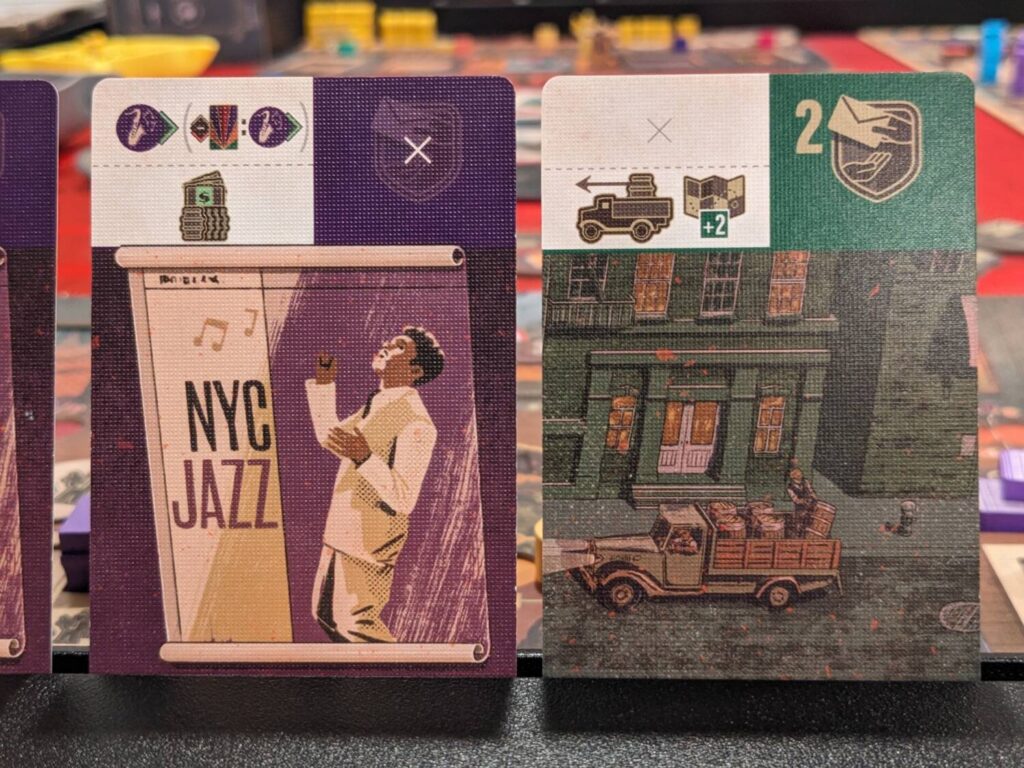
The rules overhead for Speakeasy’s normal multiplayer mode lands squarely in the middle of his strategy game output. I think BGG’s weight ratings are mostly on point—The Gallerist, Escape Plan, and Vinhos: Deluxe Edition are medium, Kanban EV is medium-heavy, and On Mars, Lisboa, Weather Machine, and Inventions: Evolution of Ideas are heavy. Speakeasy lands in the Kanban EV range of weight and can be taught in about 30 minutes. Speakeasy has a round structure that makes sense, three clean-up phases that are a mix of administration and area-control scoring, then a final turn similar to Vinhos: Deluxe Edition and Inventions: Evolution of Ideas where players get one more turn to close out their affairs before final scoring.
I’m caught up in discussing the rules for one reason: Lacerda, lately.
A number of players in my groups have begun to sour on Lacerda games because the designs have simply gotten too heavy. Save for Kanban EV, Lacerda has pivoted to making games that are very difficult to teach…the On Mars and Inventions teach videos, done by Paul Grogan of Gaming Rules, both run north of 45 minutes, and they are done by a professional who in at least one case literally wrote the rulebook. Most regular humans I know can’t teach a heavier Lacerda design in under an hour.
Lately, the themes have not always landed, either. This is somewhat shocking given that Lacerda is widely credited with building the most thematic strategy games of the last 10 years. I’m the first to defend the gameplay of Inventions: Evolution of Ideas, but the theme is mostly window dressing and I sure as heck don’t want to teach it unless I have an extra 45-50 minutes to spare before playing the game.
Speakeasy is, for someone like me who wants to play games in that 3.50-4.00 BGG weight range for a “heavy” game, a welcome change from his two previous strategy efforts (I’m not including lighter fare like Mercado de Lisboa, for example). In the words of two players who joined me for review plays, Speakeasy is a “return to form.” If you prefer your Lacerda games to be “highly thematic, easy to learn, and difficult to master”, you should plop down the cash for Speakeasy right now.

It Might Be Time to Start a Mob War
Once the game gets going, Speakeasy leans into its theme so hard I needed to pour a nip of bourbon and slip on a fedora just after starting a Prohibition-era jazz playlist on Spotify.
Speakeasy plays out over 11 turns (yes, only 11 turns!) across four Acts. A bit like the turn structure of Inventions: Evolution of Ideas, the game’s first decision point is actually the Setup Round, an important step that players must take to establish their initial presence by building their first structure in one of the three Zones of the map: Downtown, Midtown, and Upper Side. (No, Manhattanites—the game doesn’t break out the Upper Side into East and West. It’s just Upper. You’ll be OK, if you can get over the fact that the board’s layout makes the Zones look like they should be called Lefttown, Midtown, and Righttown, given the left-to-right design of the map on the board.)
Each Zone is broken into a number of Districts, with each District hosting 2-3 building spaces where a player can build structures or ambush the game’s non-playable Mobster faction to take over additional buildings. Even placing your first building—which will help when each of the first three Acts ends with the “Lucky Luciano Phase” to score each Zone—is an interesting choice, and this gives Speakeasy legs right from the jump. Like the Splotter guys try to remind us from time to time, this first choice might lose you the game, especially if you look up and realize you’ve built in a tough spot or overspent on your first building.
During each round, players will place one of their Capos (workers) on one of a variety of spaces to trigger actions. Some actions let you produce booze; others let you drive around town with your trucks, picking up booze at your Stills or buying it from a “Rum-runner” ship then driving booze to one of your structures. One space even lets you ambush a Rum-runner, using the combined strength of both your own and other players’ “Family Members” at a ship’s location to rob a ship, steal a barrel of booze, and grab a Crate that provides a bunch of cash that can be used to keep your business running smoothly. That Crate also grants its new owner an ongoing player power that was surprisingly substantial in my experience robbing boats.
You can build speakeasies. You can upgrade those speakeasies into better, high-valued buildings—nightclubs and casinos. You can build your Stills, the only building each player has that can produce its own liquor.
You can sell booze from your businesses, and in a reminder that buying drinks at a club is way too expensive in real life, players make more money when selling booze from clubs and casinos than their speakeasies. You can hire the help of local (and expendable) goons that can boost the muscle you’ll need to take over Mobster buildings or defend yourself during a Mob War.
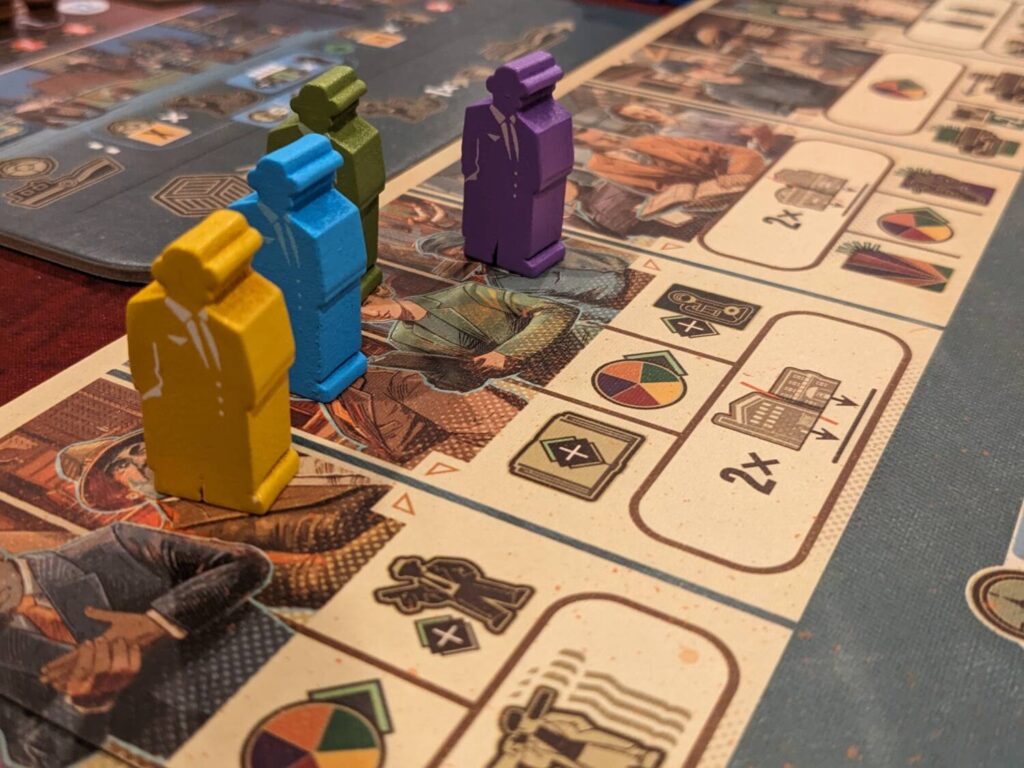
Some of the game’s actions boost the strength of a player’s Operations, which are displayed on each player’s personal player board. These four powers—the VIP Room, Party, Stills, and Fleet—grant players the ability to slowly increase their capacity to do the game’s most basic actions. You need to boost the Party track to sell more barrels of booze during the sale action. Get your Fleet track to level 3—each Operations track goes up to level 5—and you unlock a second truck to drive your booze all over town, important if your empire spreads out enough for you to need the extra hauling space.
The game’s fifth tracker is tied to Strength, which measures a player’s ability to attack the Mobster faction as well as defend a player’s buildings during a Mob War. All five of these tracks combine to total a player’s Infamy rating, tracked along the right edge of the main board.
Like any good track, Infamy grants a player sizable bonuses as play goes along—instant cash bonuses, an increased value of sales per barrel of liquor, extra Family Members, and immediate card draws. It’s easy to track Infamy since it’s just the total of your five personal tracks, and making the Infamy track your life goal is not a bad way to track how well you are doing in the game.
All of this should get you excited for Speakeasy if you are a fan of the game’s theme. Almost every action you take, right down to the idea that you are “cooking the books” by securing large financial milestones, makes you feel like a criminal. And this is the “return to form” that nearly everyone who joined me for a play of Speakeasy called out.
Speakeasy feels like a game Lacerda designed five or six years ago. It’s a theme-first design that makes every action fit into its world, even if some of the rules occasionally struck me as a bit too “gamey.” (We’ll come back to this.)

The Flavor Art? It’s in the Window
While Speakeasy is first and foremost an area control game, it’s also a hand management game. Regular readers of my content know that I’m a huge fan of hand management games, so it was great to see that some of the tension in Speakeasy is tied to the hand of cards you’ll need to survive.
But first, a note about the cards. Each player’s Operations board holds slotted cards in a way that shows the art on each card. With some confidence, I believe that this is the first time I’ve seen a player board do this. I don’t know why the decision was made, but I love it.

Once a card is played, it is comfortably slipped into a slot based on its Operations type. A single number displays in the upper right-hand corner (Leverage, which we’ll get to), but the majority of the card’s real estate is artwork provided by your friend and mine, artist Ian O’Toole. The card slot, when empty, is one of four windows in a building where your gang is headquartered, with a view of the street below from two of them and posters/paintings in this imagined Mafia lounge in the other two slots.
When filled with cards, you get to see things happening on the street, and the drawings make each player’s board look pretty slick. The VIP Room cards were my favorite; each VIP Room card looks like you can make out two people talking, but you can’t tell what they are discussing. The angle is perfect, the images are interesting, and different people are featured on each card. It is a really cool way to feature O’Toole’s art without burying or covering up the images, adding spice to the proceedings.
The cards themselves come in five flavors—four are tied to the game’s Operations tracks (VIP Room, Party, Stills, Fleet). The fifth type of card is the Helper card. Helper cards are earned through a variety of actions, and one Helper card can be played at the start of a player’s turn to take an action or gain a minor bonus. (This, in effect, is the only “executive” action in Speakeasy, for those familiar with the designer’s use of bonus actions in nearly all of his games.)
Each Operations card—with a new card drawn at the end of a player’s turn every round—has three facets beyond O’Toole’s artwork. The first is the bonus that is earned when a card is played. Sometimes, it’s a simple boost on one of the Operations tracks. Sometimes, you get to burn a second card to go up a second time on the same track. (I did this almost every time I had the chance.) Sometimes, it’s a better bonus—a Family Member, or maybe a Helper card.
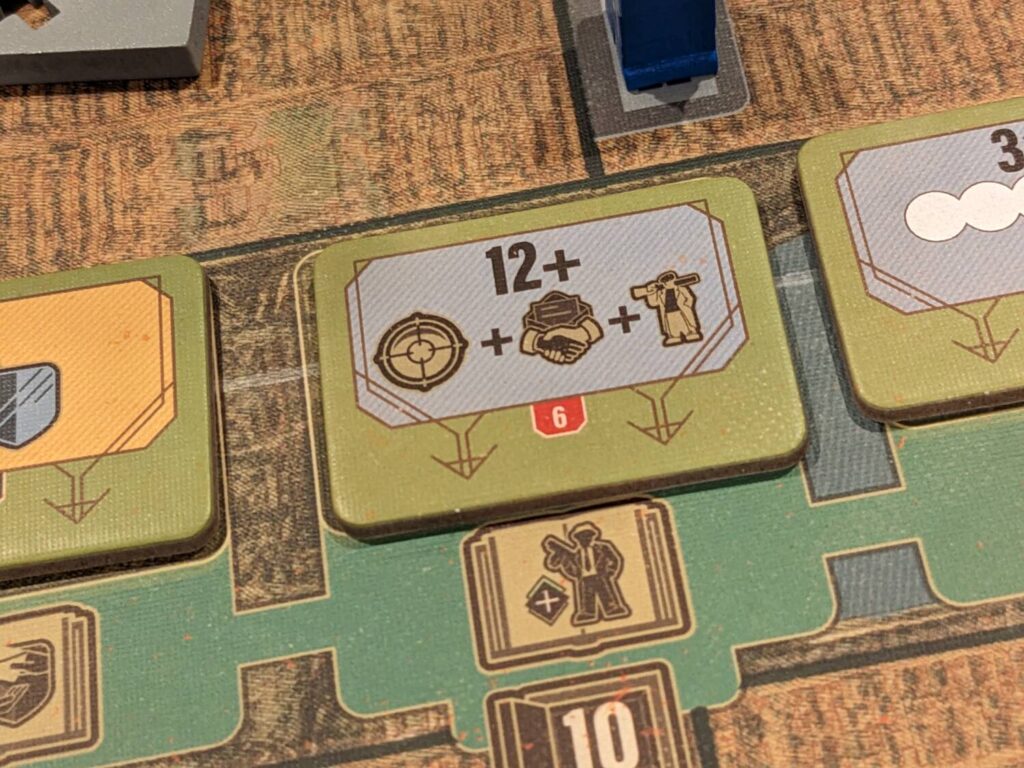
The second facet is tied to the action you’ll take when playing the card. This action is always the same for that flavor of Operations card, so if you play a Party card, you will always have a chance to sell barrels equal to the level of that track on your Operations board. Seeing an opposing player’s hand (just using the color coding and symbology on the backs of each card) is incredibly helpful. If a player doesn’t have any Stills cards, they probably won’t take the production action on their next turn, meaning they are probably not going to use the Ambush spaces because it would be a waste to use only half of that worker placement space’s available actions.
The third facet on Operations cards is the Leverage number, used when players need to place Family Members. Family Members are your most trusted soldiers in two ways. Usually, players will use Family Members to protect their buildings. In another great thematic nod to the way mobsters may have operated back in the day, Speakeasy requires buildings to be “operating”…and the best way to ensure a building remains in operation is to plant a Family Member outside the front door, so that the cops (and there will be a cop in each district by the end of the game) turn a blind eye to what the mob is trying to do in that nightclub downtown.
Leverage is a mix of a standing value (delivered by cards that are slotted in your Operations board) and temporary Leverage gained via tokens that can be earned through game effects. The cost of placing new Family Members is directly tied to turn order—the higher you are in turn order, the more expensive it is to place a Family Member.
And that leads us to the Restaurant space…the single-best individual space Lacerda has ever designed.

Yes, I Said That
When I first read the rules to the Restaurant space, it felt like a pass action. The Restaurant, humbly residing in-between other action spaces across the top of the Speakeasy board, is the only space that accommodates an unlimited number of Capos, a sign that this is a place you probably don’t want to go, if my experience with hundreds of Euros over the last 10+ years is any indication. It’s the spot where players can go to change turn order…and to even use the space, you need to discard one of your Operations cards to visit.
I have been openly critical of Lacerda’s designs regarding turn order with his last two games. Weather Machine didn’t seem to care about turn order at all, and Inventions: Evolutions of Ideas never really forced me to consider going first through its main action to change turn order (the Eureka action), and I won four of the five times I played Inventions, including two plays where I went last the entire game.
Speakeasy turned those thoughts about turn order on their head right away, thanks to two factors. The Leverage value, referenced above, is one of them. The player going first has to spend four Leverage to place a single Family Member. Now, if you have the right cards slotted in your Operations board, no sweat, you won’t need to worry about having enough Leverage to place 1-2 Family Members every time you need to protect your buildings. But if you don’t have the right cards slotted on your player board, you’ll want to go later in turn order, where the Leverage price drops to as low as one Leverage per placed Family Member (in a 4 player game).
To move your turn order marker to the last two positions in a 3-4 player game (or second, in a 1-2 player game), you have to spend an additional Operations card on top of the one you spent to visit the Restaurant in the first place. Suddenly, you’re looking at the few cards you have left, and realize that you might not want to go third or fourth after all. But that Leverage number is so juicy when it is low!
The second factor for turn order? Going last in an area control game is often vital. You want to be able to analyze the landscape and know that you can swing the tide in a Zone control battle by taking the last turn before Lucky Luciano shows up and hands out cash based on who controls the most districts in a Zone. And maybe you can take the actions you want from that final turn-taking position in a round…maybe. (The game’s action spaces mitigate scarcity by offering a location called the Park, where players can go to swap their Capo with a space occupied by a different player’s Capo, giving the displaced player a minor bonus. Even then, the spots in the Park are limited.)
Now, if the Restaurant was only tied to changing turn order, I would still say it was an upgrade over almost every game Lacerda has designed when it comes to specifically changing turn order. But then the Restaurant does something better: it slowly makes itself the most desired space in the game.
The Restaurant is the only space in the game where a player can claim public milestones, and this action (“cooking the books”) is only found at the Restaurant, not on Helper cards or any other tile action. So, this aligns with other games like The Gallerist, where players have to choose to claim these big scoring goals by taking a separate action at the International Market.
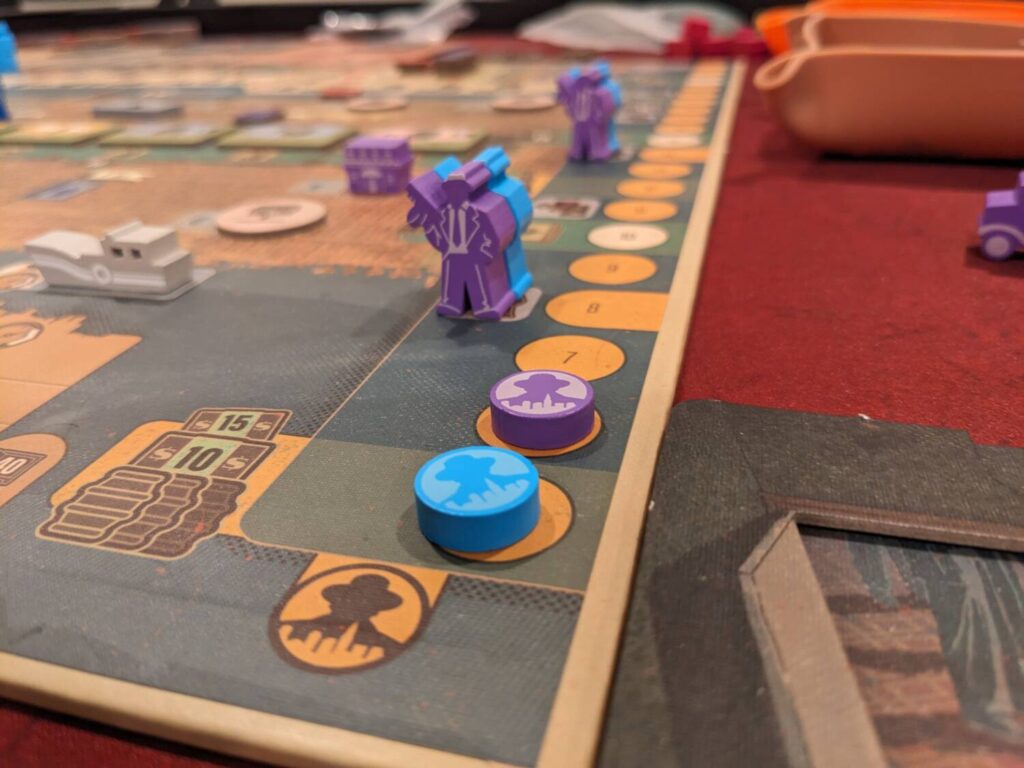
The Restaurant offers players a chance to take two of the following three actions (and the two must be different):
- “Cook the books”, to score limited public milestones by dropping a book token anywhere a player is eligible, based on the conditions of a space. One of the downsides of the Speakeasy map is that these milestones are spread across so many parts of the board that it can and ultimately did prove to make it easy to forget what spaces one might be eligible for during this action.
- Play an Operations card, which means a player will get both an immediate bonus and the ability to take a normal card action.
- Play two City tokens, which were seeded in building spots during setup and spread across a small market at the bottom of the board. These tokens can be selected from the market during certain actions or taken as soon as a player builds a new structure in a space or takes over a mobster speakeasy. City tokens range from taking a card to boosting an Operations track to completing full-blown turn actions, like building casinos or protecting buildings.
All of this made the Restaurant ridiculously awesome. Savvy players might come to the Restaurant to change the turn order and go last instead of first, then take as many as three standard actions before ending their turn. Some of the best combos in the game came from the Restaurant, and in one of my four-player games, six Capos were sent to this space between all players during a single Act (so, out of 16 total actions, six were done at the Restaurant), leading to a volley of turn order changes and combotastic rounds.
Even juicier: when anyone sends a Capo to the Restaurant and changes turn order, anyone with a casino gets a $3 payout per casino at the end of the current round. Building a casino early on (each player can build up to three casinos during the game) means the casino will usually pay for itself by the end of the game.
Blocked out of another action? The Restaurant isn’t a bad place to be. Want to take back-to-back turns, by going from fourth in turn order to first in the next round? Restaurant. Want to trigger combos on the milestone scoring by cooking the books, then use the new bonuses to make better use of a couple City tiles? Restaurant. Want to force an opponent into the first turn spot by moving your turn order marker behind them, so that this opponent suddenly cannot afford to deploy all their Family Members on the next turn?
Restaurant, Restaurant, Restaurant. I looked back at the boards for all the Lacerda games I own, and it’s official—the Restaurant space in Speakeasy is the single-best space Lacerda has ever built into a game. It’s better than the first space in R&D in Kanban EV (gosh, how many times have I gone there to snake the first car or two on the test track from an opponent?), it’s better than the Artist’s Colony in The Gallerist, and it is better than using the Innovate action to start combos in Inventions: Evolution of Ideas.

Cash in Hand? Nah, Let’s Just Launder It
Speakeasy does something interesting with money—it often forces players to decide if they want to take a loan from themselves, at a rate of double the money’s worth.
Let me explain. Players begin the game with $15 “cash in hand”, which is freely spendable. They also begin play with $30 in their safe. Safe money is always available, but to use it, players have to launder the cash from the safe at a rate of 2:1. (Money laundering is a free action.) That means that if you try to spend $10 from your safe, it actually costs you $20 to spend it—$10 for the cash, and $10 for the laundering.
Even though the rulebook stresses that players should consider dipping into their safe from time to time, it was comedy to watch players protest that money was tight and that they didn’t have any money. “What about the $30 behind your safe screen?” I would respond.
“No, I can’t do it, man,” someone might say. “It just feels bad to spend that money and ‘lose’ so much in the process.”
This is not an exaggeration: in every single one of my multiplayer games (five plays), the player who won spent the most money from their safe. Even though I’m telling you that, and I’m telling you this is printed in the “Tips” section at the back of the rulebook, players will still not want to spend money from their safe, even later in the game when the pot of gold behind your safe screen is big enough to freely take loans from it.
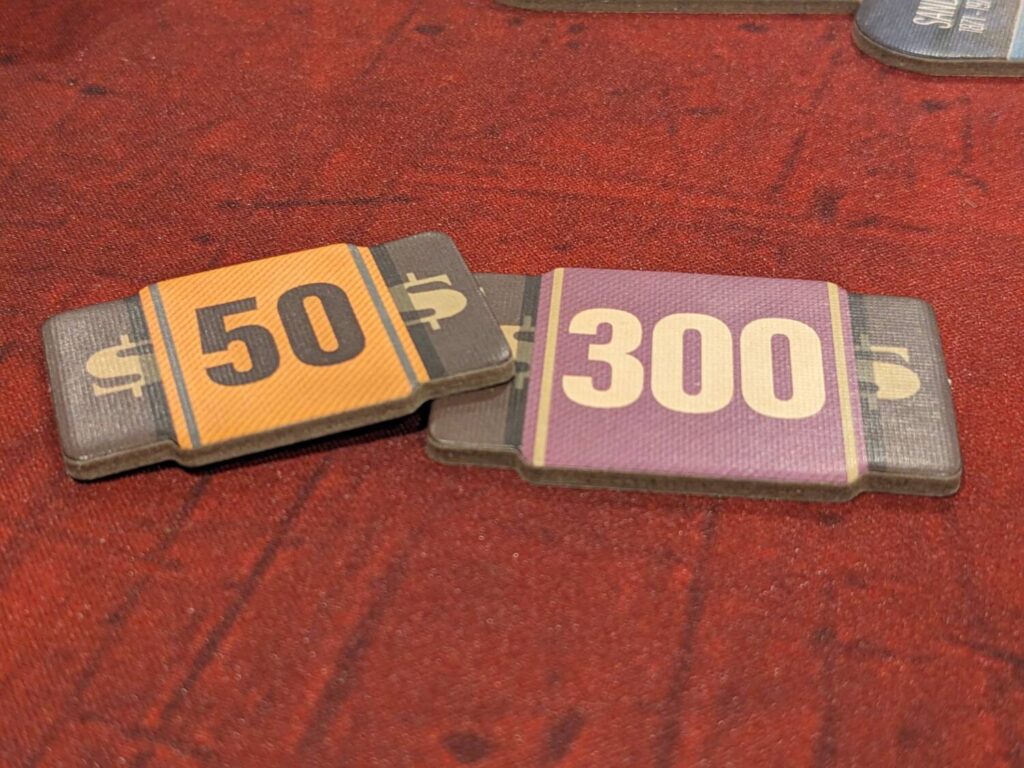
That makes the entire concept of money quite interesting in Speakeasy. You can only get cash in-hand by doing a few activities, mainly selling booze and raiding Rum-runners. Usually, cash goes into your safe, particularly when a player cooks the books or wins a Zone battle during the Lucky Luciano payout phase between Acts. But you need cash to do so many things in this game that money feels very tight early on before players get their barrel sales network rolling or after raiding a Rum-runner or two for cash.
Cash is your final score in Speakeasy. This was also true in The Gallerist, but scores scale much higher in Speakeasy and it makes one feel like they truly grew something special. We treated each dollar like it was a million bucks, so if someone got a $5 payout, we decided that this meant a $5 million payout. If I’m a mobster, I’m making big bucks, right? If anything, this might have been a miss by referring to the money here as single dollars instead of thousands or millions. (Dear Vital—change the monetary unit from singles to millions. You’re welcome.)
One final note about money: Lacerda’s obsession with chunky money bits is on full display once again with Speakeasy. Like the currency tokens from Escape Plan, The Gallerist, and Vinhos: Deluxe Edition, the thick cardboard tokens used in Speakeasy feel so good to manipulate that I was not once tempted to swap in my Iron Clays. I also loved that the higher denominations are physically larger tokens, so the $300 token is noticeably larger than the $1 and $5 tokens. Good. I’m a mobster and I wanna feel “boss”, baby!!
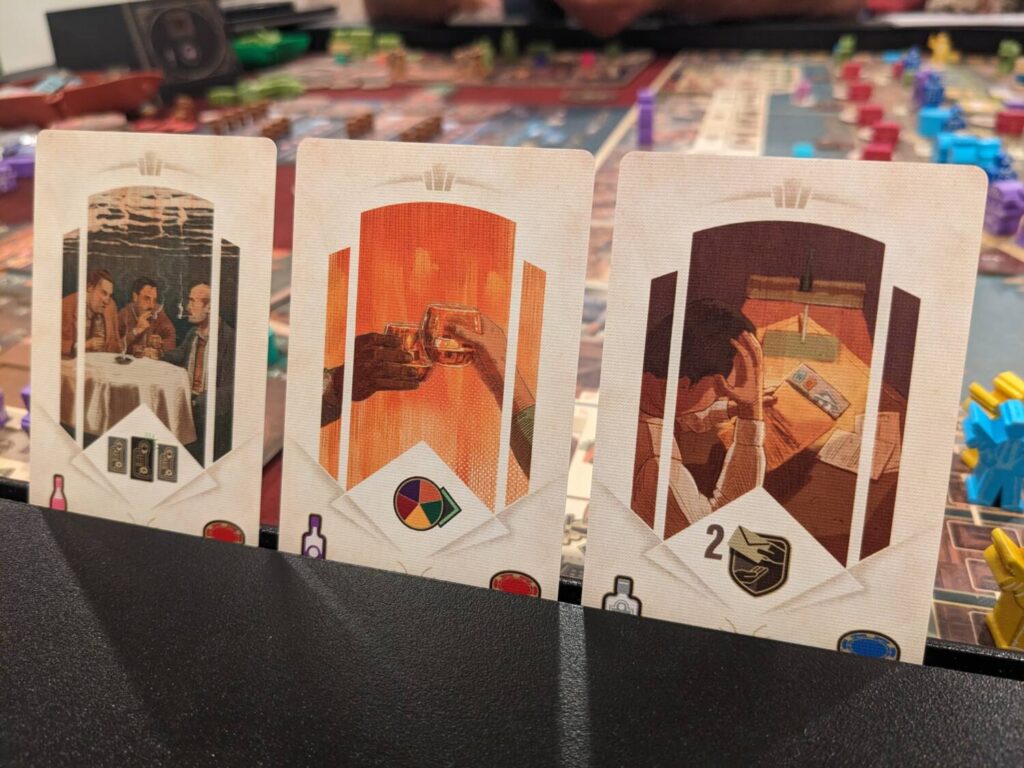
Occasionally, A Horse’s Head is Gonna Show Up
A few elements of Speakeasy did not work for me, a mix of personal preferences and design elements.
The first and most glaring issue, which was noted by all nine unique players who joined me for review plays, is the concept of building a winning strategy around the purchase, production, pick-up and delivery of barrels by overindexing in the Fleet, Stills, and Party tracks. Boosting the tracks needed to first build a lot of speakeasies, clubs and casinos, while creating a network of strong Stills production, a second truck to move barrels around, and boosting the Party track to make sales more efficient seemed substantially more daunting as an area of focus. Ultimately, no one was able to figure this out and formulate a winning strategy. (The game where I posted my lowest score came through pursuit of this strategy.)
The rules make the booze production and delivery strategy doubly challenging because, for reasons that only make sense as a board game, each structure can only hold one barrel at a time to sell. (This rule is broken by the Stills, because barrels can only be produced there, not sold.) That means that you have to spend a turn to produce barrels or drive around and buy barrels before driving them to your buildings, then take a separate action selling the booze, up to your Party limit (2-4 barrels).
The money yield could be high if a player moves high enough up the Infamy track, which boosts the sales value of each barrel. Because barrel sales equate to cash in hand, selling barrels is a great way to boost spending cash without taking the hit on money laundering. But in a game with 11 turns, I’m not confident that a player could focus only on this and still win. It can be challenging at times to string together the turns you need to boost all the proper tracks, and you still want to find ways to protect all built structures so that they will score at the end of the game, meaning that you really can’t ignore the VIP Room track, used to deploy protection. Businesses can only accept a barrel or sell barrels if they are operating, and as the game goes along, buildings eventually need protection to remain in operation.
We found barrel production and delivery to be something saved mainly as a secondary action. In the game I sold barrels most often, I only took the dedicated sales action twice during the entire game (by playing a Party card or using a bonus from a Helper or City token). Taking Fleet actions also means spending time moving trucks to Rum-runners to buy barrels then selling them at a lower profit margin than if you steal them from those same Rum-runners, so attacking boats seemed much more efficient than buying barrels from boats. (Also, I’m a mobster. Why would I want to go to the store and buy booze when I can load up my car with Tommy Gun-toting gangsters and just steal it?)
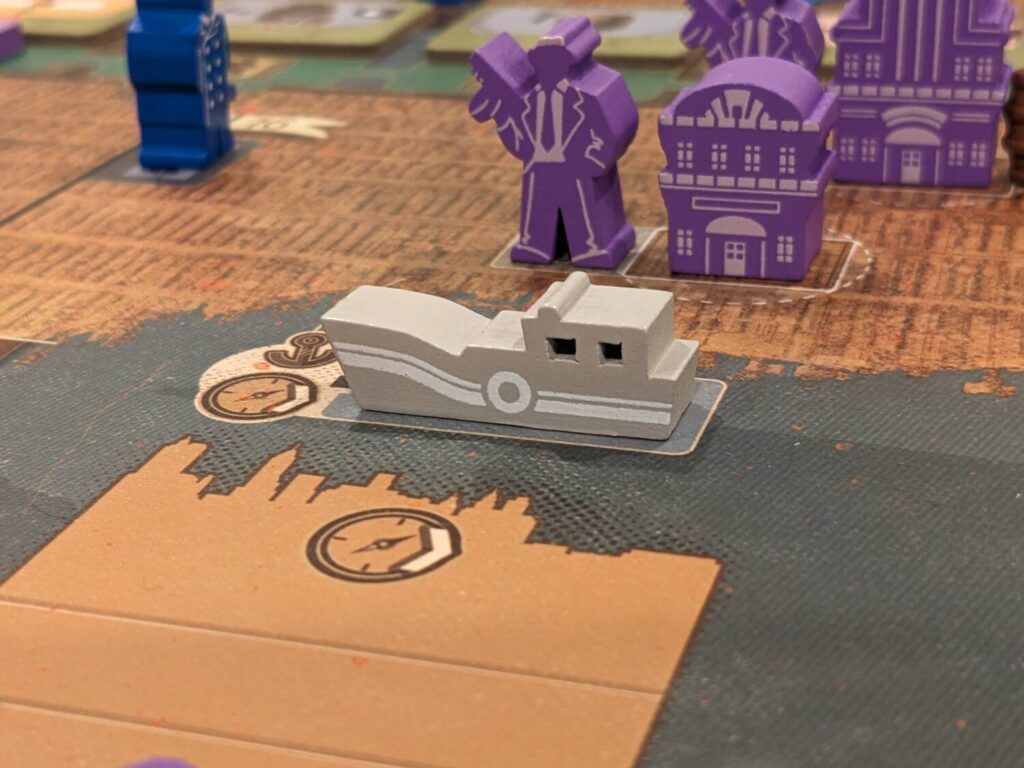
The second design element I had an issue with: nightclubs, the bastard stepson of the casinos. Everyone agreed that these buildings should come with some sort of power—maybe a small cash bump if booze is sold from a club (again, in real life, booze prices are highest at clubs, not casinos, where many people drink for free), or maybe a small payout similar to casinos—say, $2 instead of $3—when turn order changes at the Restaurant.
Sure, casinos do not grant an immediate bonus when built, whereas nightclubs and speakeasies do, and that’s certainly important. But we found most players sticking with a strategy of building a lot of speakeasies and a couple casinos, especially since Zone scoring is determined using a structural hierarchy that places casinos above nightclubs. Maybe an expansion or a rules tweak will change this, but today, clubs just seem like the buildings I will build last.
Speakeasy is not a direct interaction wargame, so players never attack other players. (This was a major relief for the majority of the Euro gamers who joined me for plays.) However, players can attack the Rum-runners and the static Mobster entity, represented by red buildings, which begin the game with total control of 4-6 districts on the map and increase their presence from time to time during Mob Wars.
Surprisingly, I found some players wanted the chance to ambush other players or demolish opponent player buildings, and I was one of those people who wanted the chance to disrupt other players in a more direct fashion.
That level of interaction is personal for me—I loved playing a car bomb on opponents in The Godfather: Corleone’s Empire, or sending in a suicide attack or opening fire with speedboats in La Famiglia: The Great Mafia War. Both of those games, like Speakeasy, are area control affairs, so this is something that is certainly out there with other mobster-themed games. Just know that it’s not possible in Speakeasy, so if your opponent gets three buildings into district 15 on the Upper Side, they are going to be there for the rest of the game, assuming they are not destroyed during a Mob War.
I like that many of the game’s City Tiles are strictly better and more powerful than others, but some players called this out as a negative. On the positive side, I loved how this made certain spots on the main map more desirable than others. On the flip side, some spaces (particularly in mob-controlled districts where a mobster’s strength is substantial) were deserted because a player didn’t want to take a City tile that only granted a single card draw from an Operations deck.
Only one thing proved to be a knock, in terms of the production. The PPC only included one player aid. The player aid itself is fantastic and lays out all the things a player will need quite well, including a great iconography guide. All indications point towards the final version of the game coming with four player aids, one per player. With player aids, sharing is not an option!
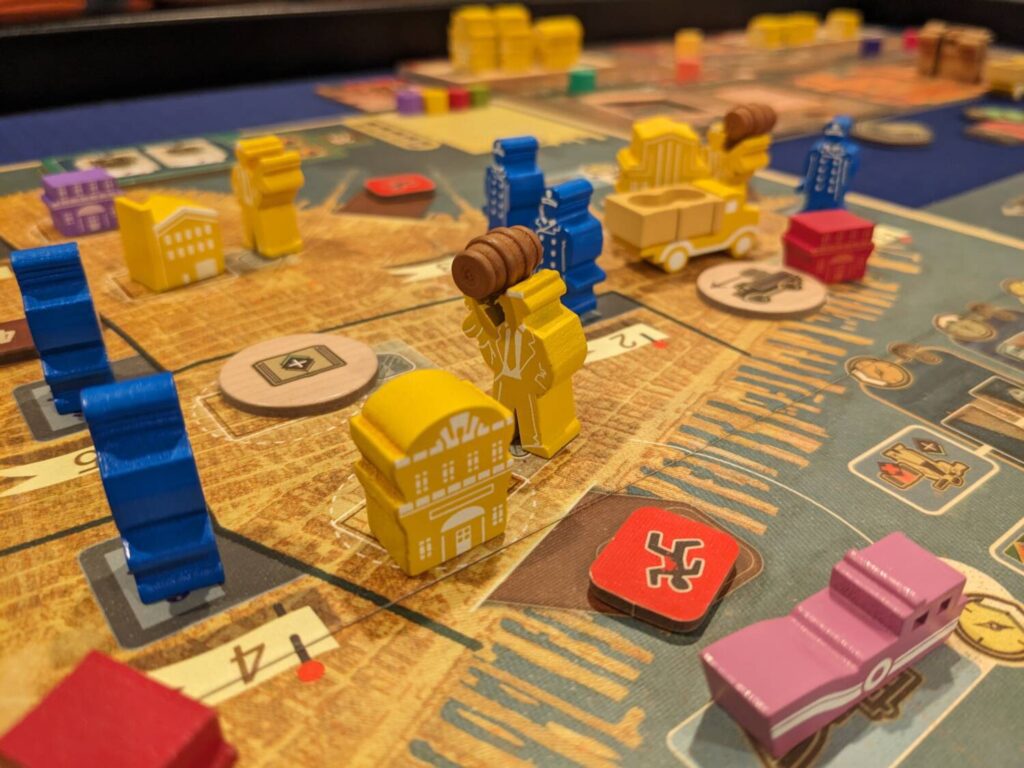
Buy It
Speakeasy is one of the best designs of Lacerda’s celebrated career. Speakeasy is highly thematic, exceptionally well produced, relatively (relatively!) straightforward to teach, and a blast to plan then execute turns. It was so much fun to play and it’s a game that is still showing off a variety of minor nuances even after seven plays.
As much as I love On Mars and Inventions: Evolution of Ideas, Speakeasy is simply an easier game to get to the table across a wider array of audiences. Speakeasy works as a weeknight game, even with the teach, especially at a lower player count.
I enjoyed my plays at all counts, but if I had to pick, I would prefer this with a full complement of four players. The flip side of the board, featuring the 1-2 player format, is tight in a good way, so even as a two-player game, I would recommend giving Speakeasy a look. While I thought the solo was easy to administer, I would not buy Speakeasy if one is only interested in the solo mode. The one issue I had with all my lower player count games: the Docks area, where Family Members are placed to trigger ambushes on Rum-runners, wasn’t as crowded, leading to less action when raiding boats.
I really enjoyed the area control mechanics in Speakeasy and I loved the way Zone scoring (the Lucky Luciano phase) is dictated at the end of each Act. Finding a way to ensure victory in a Zone was a fun puzzle in every game, and there’s no way (that I saw) to completely avoid scoring at least something during each Lucky Luciano Phase and still win. Ties are so powerful during that step, particularly in Midtown where payouts are lower. Winning even a single district in each Zone was often the key to victory. I’ll happily take third-place money in every Zone, because that drip is so crucial when a player needs cash to operate in future rounds.
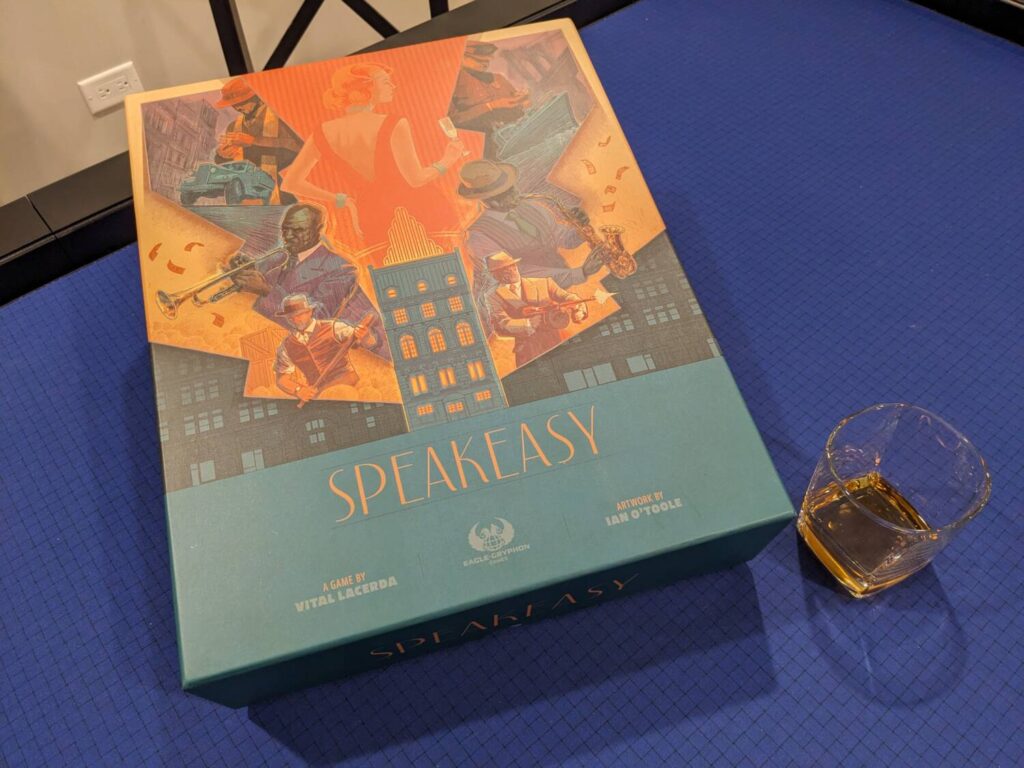
Speakeasy is an incredible production (typical for an Eagle-Gryphon game), with some of the best player boards and toys featured in a Lacerda game yet. The trucks might end up as my favorite single component of the year. Driving barrels around the map or slotting cards in the Operations board feels good. The various historical characters featured as mobsters in the game created fun narratives throughout each play, especially when a player “associated” with a gangster then used them to protect their buildings during a Mob War. Little touches, like the bloody chalk outline on the tokens used to preview which districts were going to get hit in the next Act, round out a sensational physical product.
As noted above, some strategies seem less ideal, the Upper Side is always a major area of focus thanks to its substantial payout value during area control scoring, and some of the game’s cards, tokens, and powers seem strictly better than others. There’s also a lot of attention paid to the setup round’s turn, and some players felt stuck trying to make the right initial move out of fear that their game might be ruined early. I disagreed with this, but I can see some players struggling with the first turn or two, particularly with an environment where money is so tight.
But the good well outweighs the bad. Speakeasy is some of Lacerda’s best work, packaged in an incredibly well-themed game that felt timeless even during my first play. I am so excited to continue exploring its world, and it helps that Speakeasy has one of my favorite action spaces in a game I’ve tried this year.
Speakeasy is an offer you can’t refuse. If you are a fan of classic Lacerda titles, buy this game!


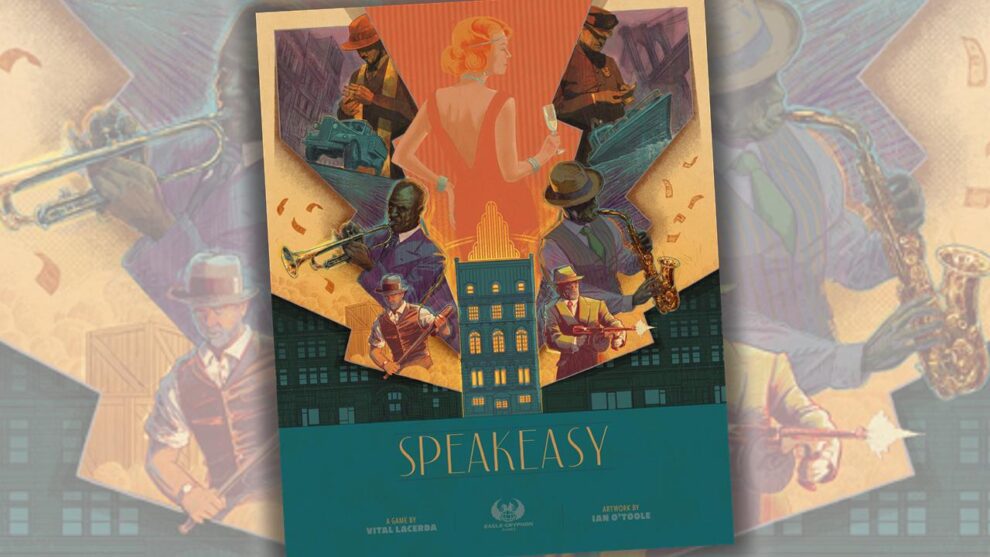








Awesome review
Great review, you convinced me to buy Speakeasy at release (although I was already halfway on board due to the art and theme). However, I disagree about Escape Plan being medium weight – the learning curve to me seems more “medium-heavy”, and it’s a hell of a teach. I can only imagine what learning/teaching Kanban is like. lol.